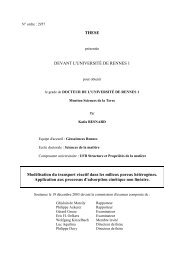Paysages virtuels et analyse de scénarios pour évaluer les impacts ...
Paysages virtuels et analyse de scénarios pour évaluer les impacts ...
Paysages virtuels et analyse de scénarios pour évaluer les impacts ...
Create successful ePaper yourself
Turn your PDF publications into a flip-book with our unique Google optimized e-Paper software.
Discussion<br />
Comparing observations and simulations<br />
The preliminary analysis of data collected on the Naizin catchment during 1993-2002 allowed us to quantify<br />
some features of the spatial allocation of management practices in farming landscapes. The dairy farm-type<br />
exhibited the tightest field pattern (AWD = 636 m), which results from accumulated constraints related to the<br />
field distance-to-farmstead: daily trips of dairy cows b<strong>et</strong>ween the pastures and the milking room, water and<br />
food supplies to grazing heifers. In Naizin, pigs are bred in buildings associated with the farmstead, thus this<br />
farm-type require farmstead-field trips only for crop management and explains why the pig farm-type had a<br />
wi<strong>de</strong>r AWD (798 m). Although it has already been observed that (i) farm-types have specific crop objectives<br />
and (ii) crop management influences the crop pattern around the farmstead (Thenail and Baudry, 2004), the<br />
challenge of the <strong>de</strong>cision trees construction was to expect that these driving factors would remain noticeable<br />
when mining the datas<strong>et</strong> at the field scale (the <strong>de</strong>cision tree growth phase). Although Fig. III.23.a showed<br />
that all the related field attributes (soil waterlogging, field area, and field distance-to-farmstead) were<br />
actually incorporated in the <strong>de</strong>cision trees, the different agronomic constraints were not fulfilled with the<br />
same level of satisfaction. Each driving factor is discussed hereafter.<br />
Crop production objectives<br />
Actually, the root no<strong>de</strong> of all the <strong>de</strong>cision trees tested the “current crop” attribute, which ma<strong>de</strong> them very<br />
similar to Markovian transition matrices, whose mathematical properties (no negative term in the matrix,<br />
ergodicity) are known to induce or maintain stationarity of crop proportions when used to simulate crop<br />
transitions (Usher, 1992; Logof<strong>et</strong> and Lesnaya, 2000; Castellazzi <strong>et</strong> al., 2007b). The trained transition<br />
matrices had such properties and the observed stability of crop proportions during the 1993-2002 period<br />
(Fig. III.20) suggests that the system already was at a stationary state. The structural similarity of the<br />
stochastic <strong>de</strong>cision trees, and the fact that more than half of <strong>de</strong>cision leaves only involved test on the current<br />
crop, explain why Stochastree and Rotomatrix showed similar performances in terms of crop production<br />
objectives. Stratifying the learning datas<strong>et</strong> by farm-type allowed to build specific mo<strong>de</strong>ls, which simulated<br />
crop proportions closer to the observed ones. However the stationarity of the observed crop areas induced a<br />
high sensitivity in the Wilcoxon tests when comparing the observed and the simulated crop proportions: a<br />
difference of 3% (in absolute value) of the farm-type total area revealed to be statistically significant but may<br />
be acceptable from an agronomic perspective (Table III.3). However, the common structure of SDT and<br />
matrices ma<strong>de</strong> Stochastree simulations also sensitive to “absorbing” crops (Usher, 1979): the area <strong>de</strong>dicated<br />
to permanent pastures kept on increasing but at a very slow speed (around 0.5 ha.year -1 ) since the only<br />
transition leading to permanent pastures was from the veg<strong>et</strong>able crop class, which was very marginally<br />
represented in Naizin (Fig. III.20) and with low probabilities of apparition (Fig. III.22).<br />
III. Stochastree, un modèle <strong>de</strong> successions <strong>de</strong> cultures basé sur <strong>de</strong>s arbres <strong>de</strong> décision stochastique – p. 93



